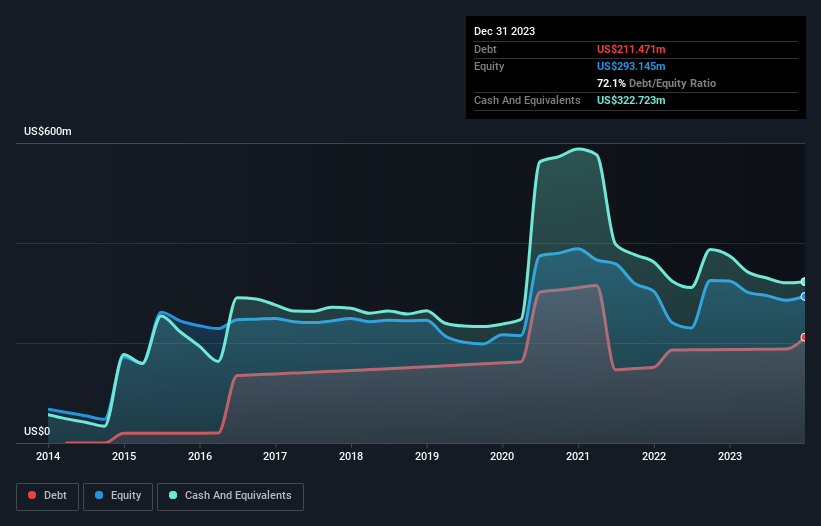
Some say volatility, rather than debt, is the best way to think about risk as an investor, but Warren Buffett famously said that 'Volatility is far from synonymous with risk.' When we think about how risky a company is, we always like to look at its use of debt, since debt overload can lead to ruin. As with many other companies Nevro Corp. (NYSE:NVRO) makes use of debt. But should shareholders be worried about its use of debt?
When Is Debt Dangerous?
Debt is a tool to help businesses grow, but if a business is incapable of paying off its lenders, then it exists at their mercy. Part and parcel of capitalism is the process of 'creative destruction' where failed businesses are mercilessly liquidated by their bankers. While that is not too common, we often do see indebted companies permanently diluting shareholders because lenders force them to raise capital at a distressed price. Of course, plenty of companies use debt to fund growth, without any negative consequences. When we examine debt levels, we first consider both cash and debt levels, together.
Check out our latest analysis for Nevro
What Is Nevro's Debt?
The image below, which you can click on for greater detail, shows that at December 2023 Nevro had debt of US$211.5m, up from US$186.9m in one year. However, it does have US$322.7m in cash offsetting this, leading to net cash of US$111.3m.

How Healthy Is Nevro's Balance Sheet?
According to the last reported balance sheet, Nevro had liabilities of US$83.4m due within 12 months, and liabilities of US$259.2m due beyond 12 months. On the other hand, it had cash of US$322.7m and US$79.4m worth of receivables due within a year. So it actually has US$59.5m more liquid assets than total liabilities.
This short term liquidity is a sign that Nevro could probably pay off its debt with ease, as its balance sheet is far from stretched. Succinctly put, Nevro boasts net cash, so it's fair to say it does not have a heavy debt load! The balance sheet is clearly the area to focus on when you are analysing debt. But it is future earnings, more than anything, that will determine Nevro's ability to maintain a healthy balance sheet going forward. So if you're focused on the future you can check out this free report showing analyst profit forecasts.
Over 12 months, Nevro reported revenue of US$425m, which is a gain of 4.6%, although it did not report any earnings before interest and tax. We usually like to see faster growth from unprofitable companies, but each to their own.
So How Risky Is Nevro?
We have no doubt that loss making companies are, in general, riskier than profitable ones. And we do note that Nevro had an earnings before interest and tax (EBIT) loss, over the last year. Indeed, in that time it burnt through US$72m of cash and made a loss of US$92m. While this does make the company a bit risky, it's important to remember it has net cash of US$111.3m. That means it could keep spending at its current rate for more than two years. Overall, its balance sheet doesn't seem overly risky, at the moment, but we're always cautious until we see the positive free cash flow. When analysing debt levels, the balance sheet is the obvious place to start. But ultimately, every company can contain risks that exist outside of the balance sheet. For instance, we've identified 2 warning signs for Nevro that you should be aware of.
At the end of the day, it's often better to focus on companies that are free from net debt. You can access our special list of such companies (all with a track record of profit growth). It's free.
Valuation is complex, but we're here to simplify it.
Discover if Nevro might be undervalued or overvalued with our detailed analysis, featuring fair value estimates, potential risks, dividends, insider trades, and its financial condition.
Access Free AnalysisHave feedback on this article? Concerned about the content? Get in touch with us directly. Alternatively, email editorial-team (at) simplywallst.com.
This article by Simply Wall St is general in nature. We provide commentary based on historical data and analyst forecasts only using an unbiased methodology and our articles are not intended to be financial advice. It does not constitute a recommendation to buy or sell any stock, and does not take account of your objectives, or your financial situation. We aim to bring you long-term focused analysis driven by fundamental data. Note that our analysis may not factor in the latest price-sensitive company announcements or qualitative material. Simply Wall St has no position in any stocks mentioned.
About NYSE:NVRO
Nevro
A medical device company, engages in the provision of products for patients suffering from chronic pain in the United States and internationally.
Excellent balance sheet and fair value.
Similar Companies
Market Insights
Community Narratives



